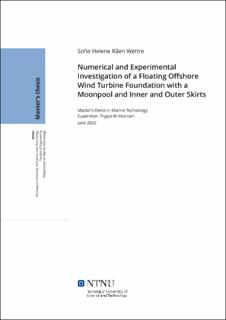| dc.contributor.advisor | Kristiansen, Trygve | |
| dc.contributor.author | Wettre, Sofie Helene Råen | |
| dc.date.accessioned | 2022-10-29T17:19:17Z | |
| dc.date.available | 2022-10-29T17:19:17Z | |
| dc.date.issued | 2022 | |
| dc.identifier | no.ntnu:inspera:106583545:37540716 | |
| dc.identifier.uri | https://hdl.handle.net/11250/3028950 | |
| dc.description.abstract | Flytende havvind har muligheten til å bli stor bidragsyter for å nå målet om et karbonnøytralt samfunn. Så langt er havvind avhengig av subsidier for å være konkurransedyktig, og innovative og kostnadseffektive løsninger trengs for at industrien kan bli lønnsom. I denne avhandlingen har et konsept for flytende havvind, utviklet av Sevan SSP, blitt undersøkt. Det flytende fundamentet består av en sirkulær sylinder med et stort moonpool og indre og ytre skjørt.
Konseptet har blitt evaluert gjennom numeriske analyser og modellforsøk i Lilletanken på NTNU, hvor målet har vært å undersøke effekten dempeplater kan ha på bevegelsene i jag, hiv og stamp. De numeriske analysene ble gjennomført i WAMIT, hvor effekten av skjørtene og dypgangen ble undersøkt, og resultatene viste at modellen var svært sensitiv til endringer i dypgangen. Analyser som etterligner modellforsøket ble også gjennomført, hvor effekten av tankveggene og tilleggsmassen fra de solide dempeplatene ble evaluert.
To typer dempeplater ble testet under modellforsøket, en solid og en perforert med en perforeringsgrad på 35 %. Platene ble testet i tre forskjellige posisjoner inni moonpoolen, hvor N1 refererer til den grunneste av dem. Både regulære og irregulære bølger ble kjørt for alle de mulige konfigurasjonene, og resultatene fra forsøkene har blitt presentert gjennom RAO-er.
Resultatene fra eksperiment har blitt sammenlignet med de numeriske, og de samme trendene i RAO-ene for jag, hiv og stamp kunne sees. Både stampbevegelsen (piston mode) og den første sloshing moden ble indentifisert gjennom målinger av den frie overflaten, og bevegelsene har blitt knyttet til bevegelsene i hiv og jag. Den solide dempelaten i N1 førte til et skifte i den første sloshing perioden, som igjen førte til en reduksjon i jag. Borsettfra det, så førte ikke den solide platen eller den perforerte platen til en tydelig reduksjon av jag, hiv eller stamp som ønsket. | |
| dc.description.abstract | Floating offshore wind has the potential to become a major contributor for reaching the goal of net zero-emissions. However, the offshore wind industry still depends on subsides to be viable, and innovative and cost-efficient concepts need to be developed for the industry to be profitable. In this thesis, a concept developed by Sevan SSP for floating offshore wind has been investigated. The floating foundation examined is a circular cylindrical hull with a large central moonpool and inner and outer skirts. %The literature on moonpools and the effects on structures are still under development, substantiating the need to further investigate such concepts.
The concept has been investigated through numerical analyses and a model experiment in the Small Towing Tank at NTNU, where the aim was to study the effect of baffles on the rigid body motions. The numerical analyses were executed using WAMIT, where the effects of the skirts and draught were examined, and the results showed that the model was highly sensitive to changes in the draught. Analyses replicating the model experiment were also conducted to capture the tank wall reflections and the added mass effects of the baffles.
Two types of baffles were tested during the model experiment, one solid and one with a perforation ratio of 35 %. The baffles were placed at three different positions inside the moonpool, with N1 being the shallowest position. Both regular and irregular waves were tested for all the configurations, and the results from the experiments have been presented using RAOs.
The experimental results were compared to the numerical, and the same trends could be seen in the RAOs in surge, heave, and pitch. The piston and 1st sloshing mode were identified through measurements of the free surface, and the motions were connected to the heave and surge response. The solid plate at N1 caused a shift in the 1st sloshing mode, leading to a reduction in surge motion. Other than that, the neither the solid nor perforated baffle resulted in a significant reduction in the rigid body motions as hoped. | |
| dc.language | eng | |
| dc.publisher | NTNU | |
| dc.title | Numerical and Experimental Investigation of a Floating Offshore Wind Turbine Foundation with a Moonpool and Inner and Outer Skirts | |
| dc.type | Master thesis | |
